Learn the difference between cutting chicken into large chunks and small dice to get the perfect texture, flavor, and cooking time for every recipe. This step-by-step guide breaks down when and why to use each technique so your chicken turns out juicy, flavorful, and evenly cooked every time.
 | Easy Kitchen Prep Guide 01.jpg)
Table of Contents
Jump to:
About This Guide
If you've ever wondered why your chicken stir-fry turned out juicy one night but dry the next, it might not be your cooking; it could be the cut. How you slice chicken affects everything from cooking time to texture and even how well the sauce clings.
In this guide, we'll explore the difference between cutting chicken into large chunks and small dice, when to use each method, and how to prep like a chef before you even turn on the stove.
Why the Cut Matters
Cutting technique isn't just about looks; it's one of the easiest ways to control how your chicken cooks and tastes. The size and shape of each piece determine how much heat it absorbs, how evenly it cooks, and even how much flavor it can hold.
- Cooking Time: Smaller pieces cook quickly, which is great for weeknight stir-fries or tacos, but they can also dry out in a blink if left unattended. Larger chunks take longer to cook through, making them ideal for stews, kebabs, and oven bakes where you want that slow, juicy tenderness.
- Texture: Every bite tells a story. Larger cuts keep more moisture locked inside, giving you that tender, meaty texture. Smaller cuts develop more browned edges and soak up seasonings or sauces more intensely.
- Flavor Distribution: Small dice pieces mean more surface area for marinades and spices to cling to, perfect when you want bold flavor in every bite. Larger chunks, on the other hand, shine in dishes where the sauce plays a supporting role rather than the main event.
- Consistency: Uniform pieces ensure your chicken cooks evenly. Nothing ruins a dish faster than finding one piece raw while another is overcooked.
- Purpose of the Dish: Think of the cut as part of your recipe design. A rustic curry or stew feels heartier with big, meaty chunks, while a light pasta or rice dish benefits from smaller, evenly diced chicken.

In Summary
- Cooking Time: Smaller pieces cook faster and risk overcooking if you're distracted.
- Texture: Large chunks stay juicier, while diced chicken absorbs more marinade and flavor.
- Consistency: Uniform pieces ensure everything cooks evenly.
- Purpose: The right cut matches the dish, think skewers vs stir-fries, salads vs stews.
How to Cut Chicken into Large Chunks
If you're planning to make chicken skewers, stews, or saucy one-pan meals, this is the cut you'll want to master. Large chunks of chicken retain their shape beautifully during cooking, staying tender and juicy inside while developing just the right amount of browning on the outside.
My Video Tutorial
In my video tutorial below, I walk you through the simple technique step by step from trimming and drying to slicing and cubing so you can see exactly how to get even, professional-looking pieces at home. Even if you don't have pictures to follow along with, this visual guide will show you how to handle your knife safely and confidently.
Practice Makes Perfect
Once you understand this method, you'll start noticing how much easier it is to get consistent results in dishes like kebabs, curries, and sheet-pan dinners. It's one of those foundational skills that instantly improves your cooking without needing fancy tools, just a sharp knife and a steady hand.
 | Easy Kitchen Prep Guide 02.jpg)
Quick Step Overview
- Start with boneless, skinless chicken breast or thighs. Trim any visible fat.
- Pat dry with paper towels so the knife doesn't slip.
- Use a sharp chef's knife and slice the chicken into strips about 1½ inches thick.
- Rotate and crosscut those strips into cubes roughly 1½ inches wide.
- Inspect for uniformity. Keep the sizes consistent for even cooking.

Chef Tip: Slightly freezing the chicken (about 15-20 minutes) makes it firmer and easier to cut cleanly.
How to Cut Chicken into Small Dice
When your recipe calls for quick-cooking pieces, think stir-fries, fried rice, or tacos, small dice is the way to go. Follow the step-by-step picture tutorial below to learn how to create even, bite-sized cubes that cook fast, absorb flavor beautifully, and give your dishes a polished, professional finish. View Quick Video Tutorial: How to Small Dice Chicken Breast Fast for Easy Meal Prep.
Picture Tutorial
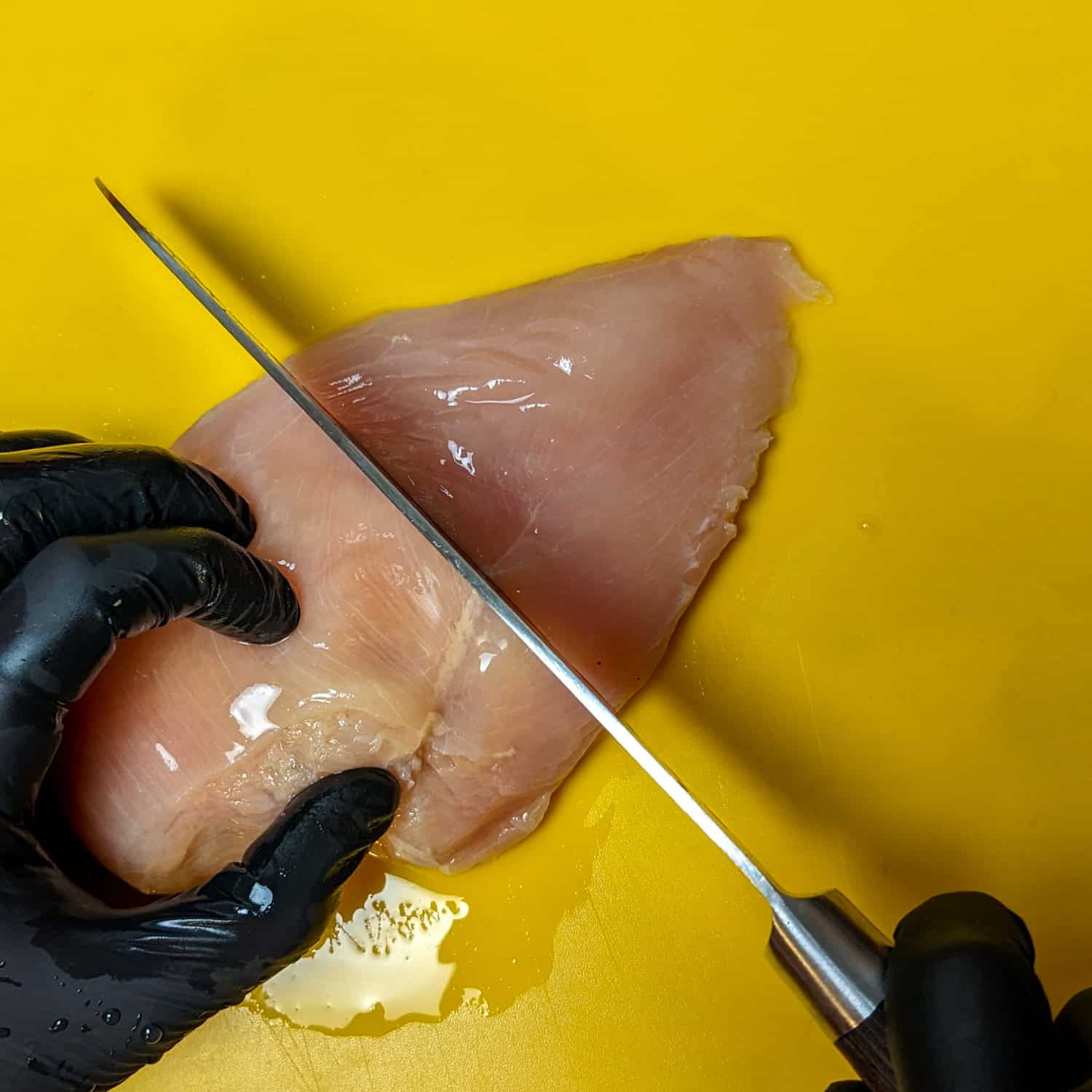
Step 01: Start with a trimmed, boneless, skinless breast and cut it in half, or skip to Step 04 to cut it into long, thin strips.
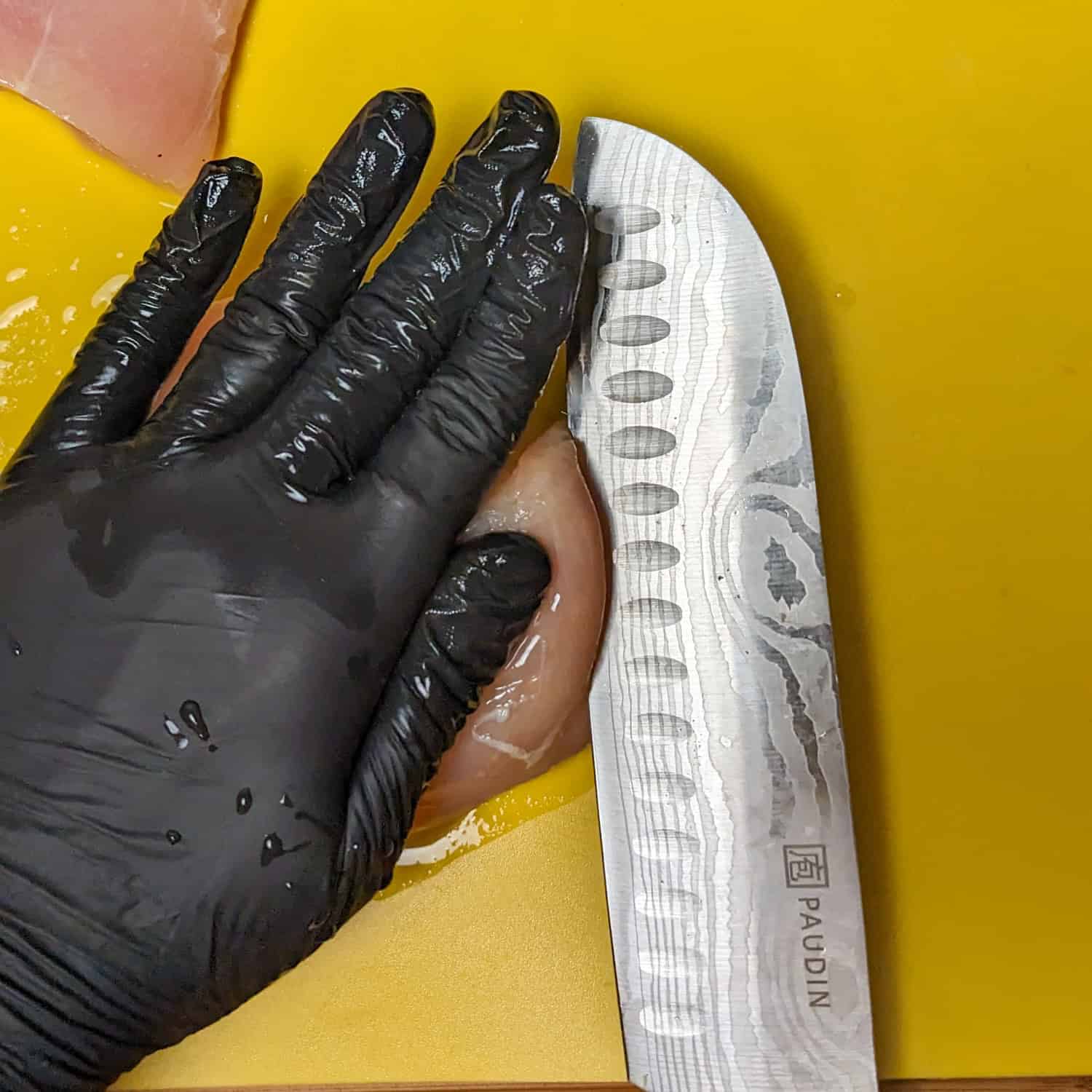
Step 02: Divide the chicken breast into two halves. Alternatively, you can skip this step and proceed to Step 04.
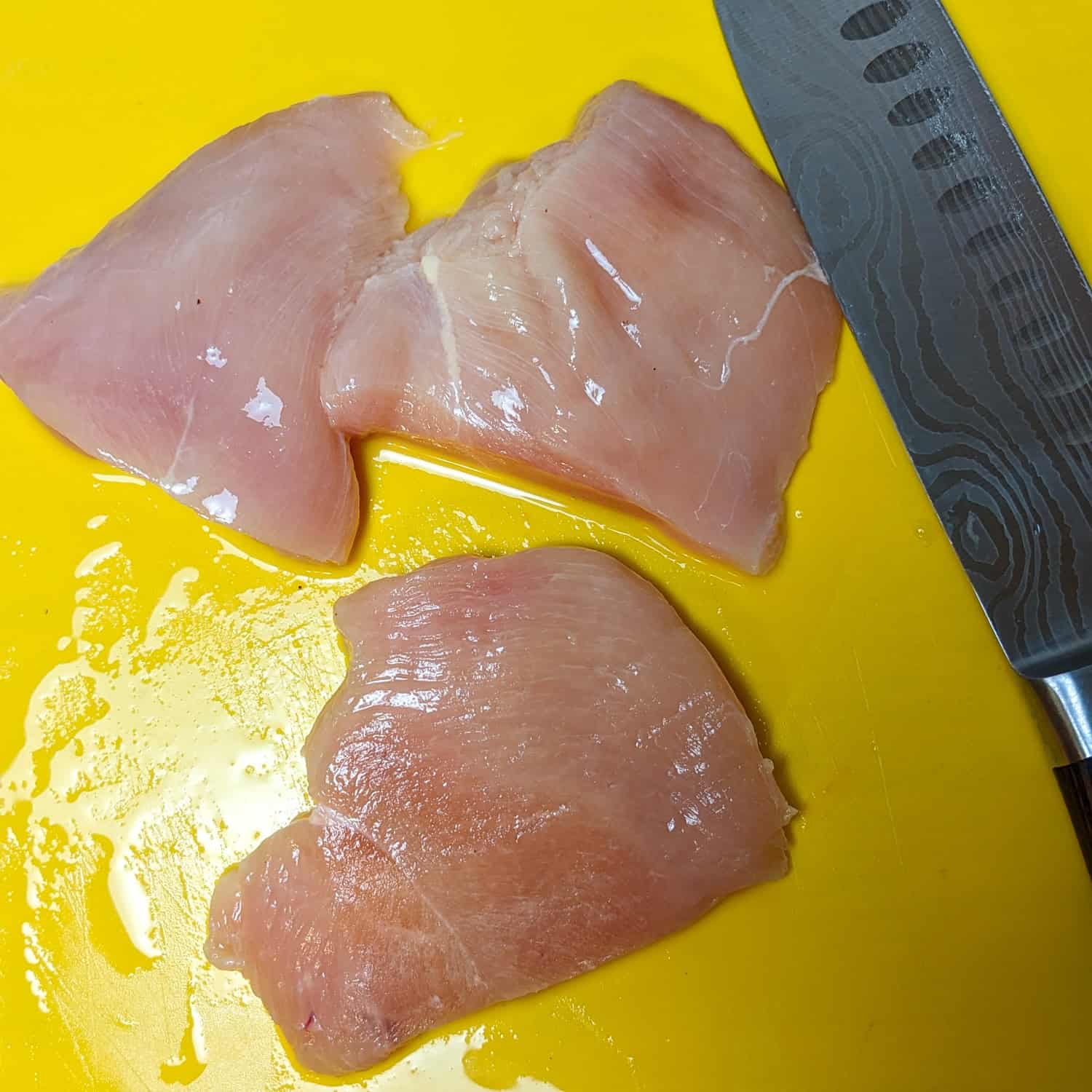
Step 03: You should have four small cutlet-sized pieces.
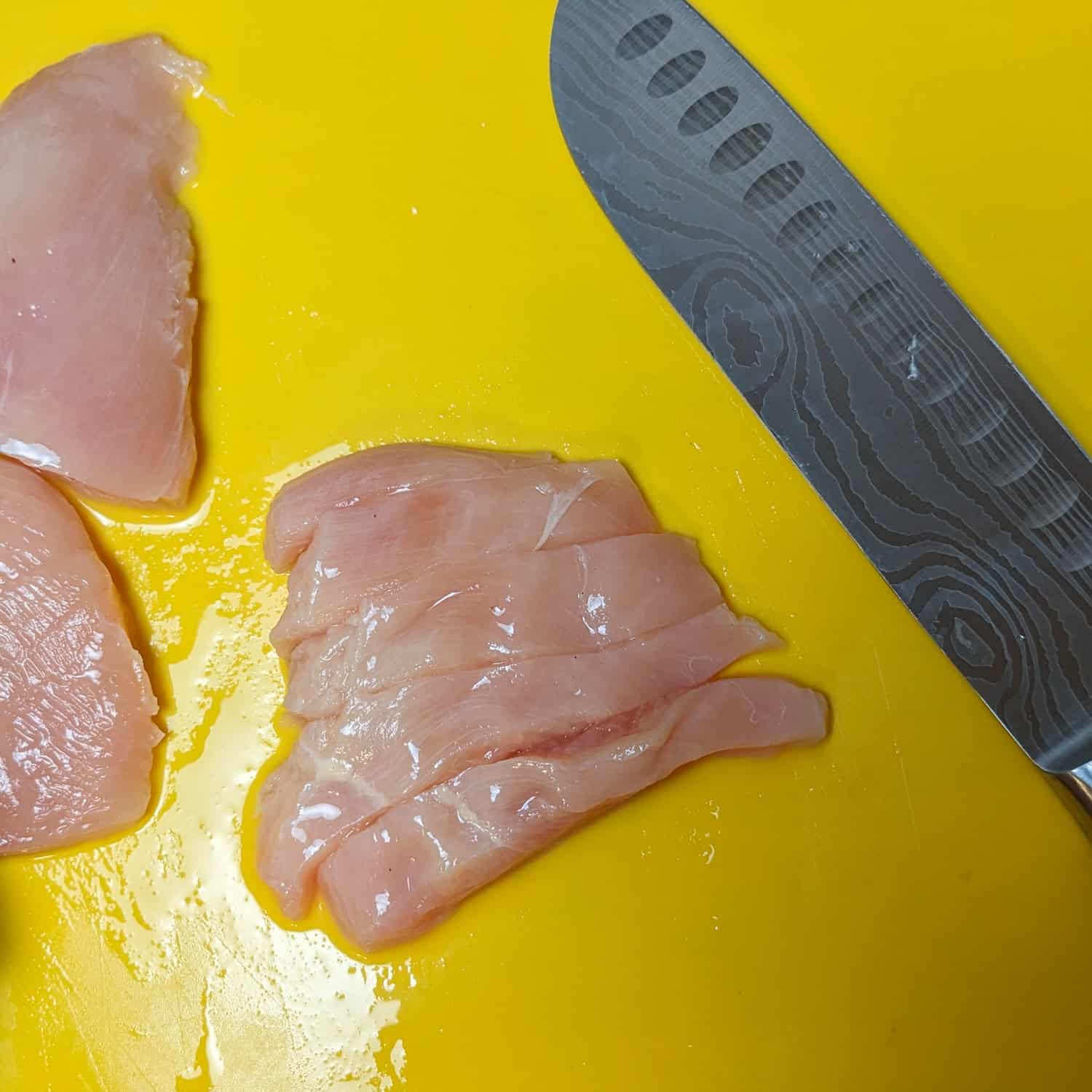
Step 04: Cut into long, even strips about ½ inch thick.
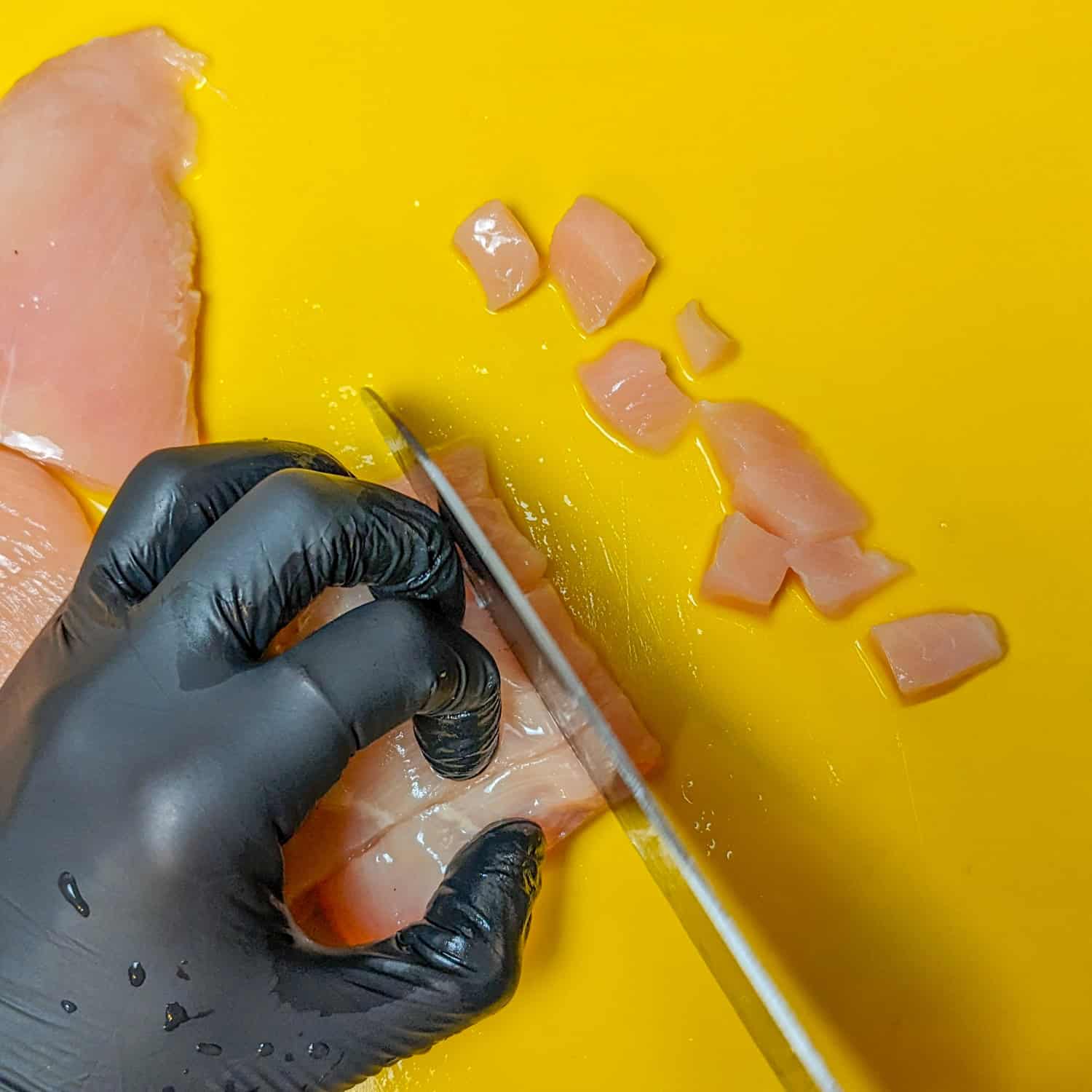
Step 05: Turn the strips horizontally and slice into ½-inch cubes.

Chef Tip: Use your non-dominant hand like a claw to guide the knife safely, tucking fingertips under as you chop. And remember to check for consistency, this is key for even browning.
Comparing the Two Cuts Chart
Now that you know how and why to cut your chicken into different sizes, let's look at how each one performs in the kitchen. This quick comparison breaks down the main differences between large chunks and small dice from cooking time and texture to flavor absorption so that you can choose the right cut for any recipe.
| Feature | Large Chunks | Small Dice |
|---|---|---|
| Cooking Time | 10–15 minutes | 3–6 minutes |
| Best For | Stews, kebabs, oven bakes | Stir-fries, soups, fillings |
| Texture | Juicier interior | More surface area for sauces |
| Marinade Absorption | Moderate | High |
| Visual Appeal | Rustic and hearty | Polished and professional |

Storage and Make-Ahead: Store prepped chicken in an airtight container or zip-top bag in the fridge for up to 2 days before cooking. If you're meal prepping for later in the week, freeze cut chicken in labeled bags by portion size. Thaw overnight in the refrigerator before using; never on the counter. Learn about Food Storage Safety, like FIFO.
Equipment
The right tools make a big difference when you're mastering chicken-cutting techniques. Having a few dependable basics on hand keeps your prep safe, efficient, and consistent, eliminating the struggle with dull knives or slippery cutting boards.
- Chef's Knife (8-10 inches): This is your main tool for clean, precise cuts. A sharp knife slices through muscle fibers instead of tearing them, which keeps the meat's texture intact. If you cook frequently, consider investing in a well-balanced, forged blade that feels comfortable in your hand.
- Santoku Knife (7 inches): A fantastic alternative to the traditional chef's knife, especially when cutting raw chicken. Its shorter, wider blade offers excellent control, and the dimples (called granton edges) along the sides help prevent meat from sticking, making it easier to slice cleanly through chicken breasts or thighs with minimal drag.
- Cutting Board for Raw Poultry: Always dedicate a separate board specifically for raw poultry. Plastic boards are easiest to sanitize; toss them in the dishwasher or scrub with hot, soapy water after every use. Using a separate board helps prevent cross-contamination between raw and cooked foods.
- Paper Towels: Patting the chicken dry before cutting is one of those tiny steps that makes a big difference. It helps prevent the knife from slipping and ensures more accurate, even cuts.
- Kitchen Shears (Optional): Handy for trimming away fat or connective tissue that's harder to reach with a knife. They also make it easier to portion chicken thighs or snip small pieces for soups and stir-fries.
- Gloves: A great choice if you wear rings, have long nails, or simply prefer not to handle raw poultry directly. Disposable gloves also make cleanup faster and more hygienic.
- Bench Scraper (Optional): This flat, rectangular tool helps transfer your cut chicken from the board to a bowl or pan without using your hands. It's especially useful when prepping multiple batches.
- Non-Slip Mat or Damp Towel: Placing one under your cutting board keeps it steady while you work, a small but essential safety step when cutting meat.
Kitchen Must-Haves Reviews
Find a collection of my reviews of kitchen equipment that I have purchased or recommend. Kitchen Must-Haves - Find other tools I use here.
My Review: The PAUDIN 8-inch Chef Knife is an absolute standout in both sharpness and craftsmanship. It stays incredibly sharp through regular use, making prep work effortless. The high-carbon stainless steel blade showcases PAUDIN’s attention to detail, while the ergonomic handle provides a comfortable grip for extended use. Despite its premium feel, this knife is impressively affordable, offering exceptional quality without the high price tag. That’s why I’ve recently switched all my knives to PAUDIN—they truly deliver on durability, beauty, and performance. If you want a reliable, well-crafted knife at a great value, this is the one to get!
My Review: This knife is well-made. Super solid and multi-functional. It is made with high-carbon steel, so it will not rust. Slicing meat like fish is easier with the grooves. It doesn’t stick to the knife. The handle has an excellent grip, and it's not heavy. For some background, a Santoku is a versatile Japanese kitchen knife characterized by its straight edge and "sheepsfoot" blade, designed for precise slicing, dicing, and chopping. Its name means "three virtues," referring to its ability to handle meat, fish, and vegetables efficiently, making it a staple in both professional and home kitchens.
My Review: I’ve used these Fotouzy Cutting Board Mats for a long time, and while they’re flexible, dishwasher-safe, and great for preventing cross-contamination with their color coding, I now prefer solid plastic cutting boards. They’re BPA-free, non-porous, and wide enough to protect my wooden board, especially handy when zesting or transferring ingredients. That said, they don’t stay perfectly steady, even with a damp towel underneath, so I give them a 4 out of 5. But I still use it a lot for quick meat and veggie preps and place them right in the dishwasher.
My Review: I highly recommend the ForPro Professional Collection Disposable Nitrile Gloves. They’re food-safe, powder-free, and latex-free, making them perfect for cooking. I’ve ordered these several times and use them both personally and for my videos. The gloves are durable and chemically resistant, offering excellent protection when handling raw ingredients. When pressed for time, they’re my go-to for preventing cross-contamination without needing to wash my hands constantly. A must-have for any busy kitchen!
My Review: I've been using the Carlisle FoodService Products CBM1016 Saf-T-Grip Board-Mate Nonslip Cutting Board Mat since my professional kitchen days, and it’s still a staple in my home kitchen today. This mat does exactly what it promises: it anchors your cutting board in place, no slipping, sliding, or unexpected wobbles while you're slicing, dicing, or carving. At 16" x 10", it fits perfectly under most standard boards, eliminating the need to fuss with damp paper towels or dishcloths. From breaking down poultry, prepping vegetables, or portioning proteins, this mat provides the commercial-kitchen level stability that helps prevent knife accidents and makes prep work feel much more secure. It’s durable, easy to rinse clean, and has withstood constant use over the years. If you're serious about knife safety or just tired of chasing your cutting board around the counter, this is absolutely worth the investment. I gave this a four-star rating because if your board is warped, you will need to use a towel instead. The mat needs to be able to grip the flat board.
Recommended Reads
- How to Cut Chicken: Several Methods for Prepping Tutorials
- How to Slice Chicken Perfectly Every Time
- How to Butterfly Chicken Breasts | Step-by-Step Guide
- Diamond Slit Chicken Breast (Video & Pictures)
- How to Pound Out Chicken Breasts Evenly | Step-by-Step Guide
5 Quick Prepping Tips
Cook's Notebook is your Cooking Tips Resource Guide. Become a better home cook with tips to help you cook more efficiently.
- Use a Sharp Knife: A dull blade tears rather than slices.
- Always cut chicken on a dedicated board for raw meats.
- Wipe and sanitize surfaces immediately after cutting.
- Keep Cuts Uniform: It's the difference between golden-brown and overcooked.
- Cut against the grain for tender results.

Cutting Against the Grain? Slicing perpendicular to the natural muscle fibers of the meat to make each bite more tender
Frequently Asked Questions
Here, you will find a list of common questions that I have answered. If you have questions, please write them in the comment section below.
It's best to let the chicken thaw slightly before cutting so you can slice through evenly without forcing the knife. Fully frozen meat can crack unevenly, making it difficult to control your cuts and resulting in inconsistent cooking.
Yes, in fact, cutting the chicken first increases the surface area, allowing the marinade to penetrate deeper and faster. Just be sure to refrigerate it while marinating to prevent bacterial growth.
Small dice work best for quick-cooking soups and evenly distributed bites. Large chunks are ideal for hearty stews that require more texture and a meaty flavor.
Cook diced chicken quickly over medium-high heat and remove it from the pan as soon as it's cooked through. Overcooking even by a minute or two can draw out the moisture and make it chewy.
No rinsing raw chicken can actually spread bacteria around your sink and counters. Instead, pat the chicken dry with paper towels before cutting to keep your work area safe and your cuts clean. Learn more about how to prevent cross-contamination.
Cooking Tips and Tutorials
If you found this tutorial helpful, you'll love my Cook's Notebook collection. From knife skills and flavor bases to time-saving tricks and essential equipment guides, this section is packed with chef-tested lessons to help you cook with confidence.
- Holiday Kitchen Safety Tips: How to Cook, Serve, and Store
- What is Salmonella? For Home Cooks | Causes and Tips
- How to Cut Up a Whole Chicken | Step-by-Step Guide
- How to Marinate Chicken: Tips, Quick Methods & Flavorful Shortcuts
Latest Recipes
Looking for meal ideas? Try these recipes:
- Fresh Cranberry Ginger Chutney | Quick and Easy
- Steak Shawarma Recipe with Fall Holiday Flavors | Easy Lebanese Style
- Haitian American Thanksgiving Recipes & Prep Guide
- Spatchcock Turkey Backbone Gravy (Mirepoix & Haitian Spices)
Subscribe to the YouTube Channel
SUBSCRIBE: 👈To my YouTube Channel to Get Notifications of New Videos.


Chef Maika Frederic
Chef and Educator
Haitian-American chef and educator Maika Frederic blends bold flavors with approachable recipes. With a background in both professional kitchens, classrooms, and children therapy as a trained chef, former teacher and technician she brings a thoughtful, inclusive touch to every dish. Through her platform, Just Maika Cooking, she shares diverse meals and practical tips to empower home cooks of all ages and levels.
Have a Comment or Question?
If you have a question or comment about this post, please post it below. You will receive a prompt response. It also helps our other readers to stay informed. Thanks!




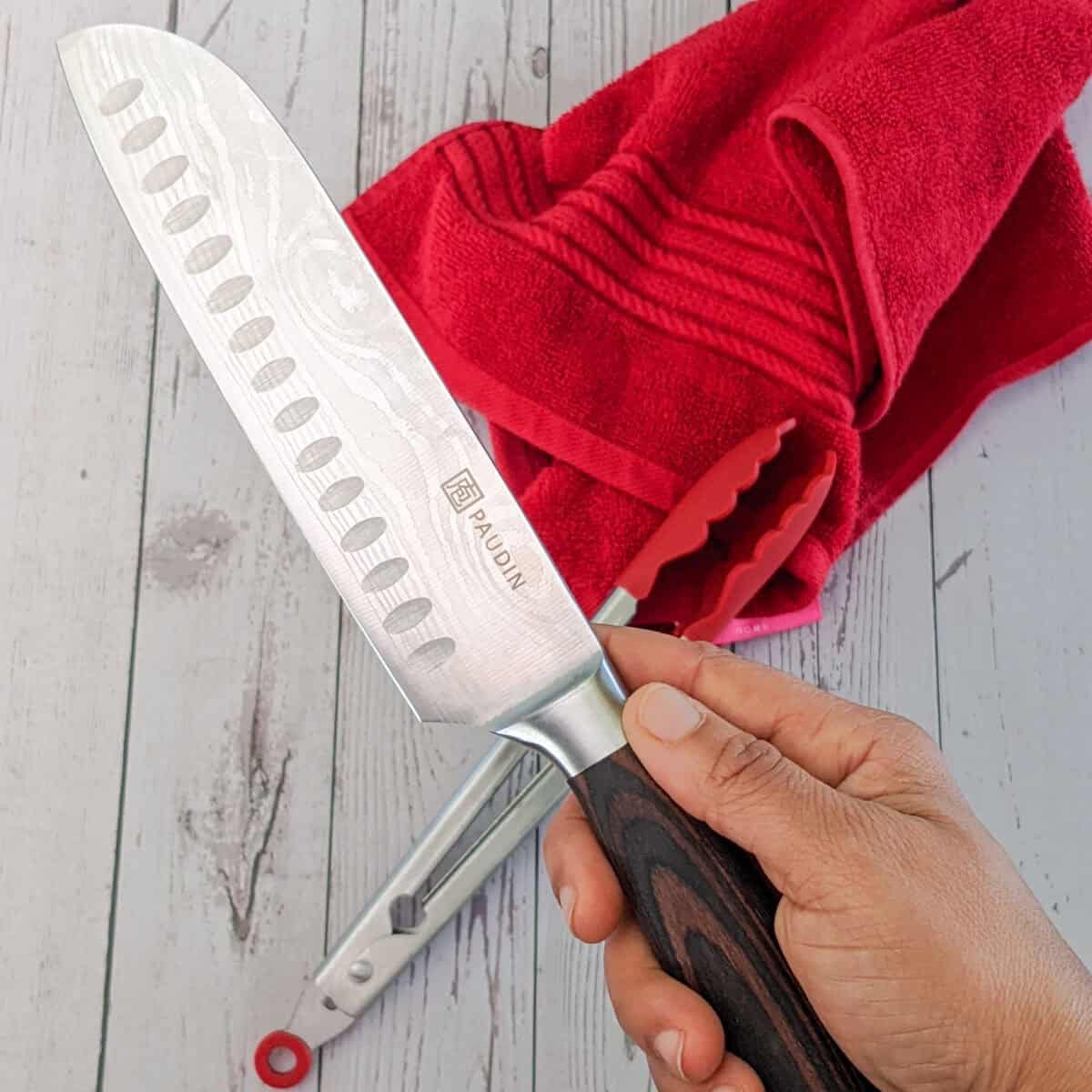
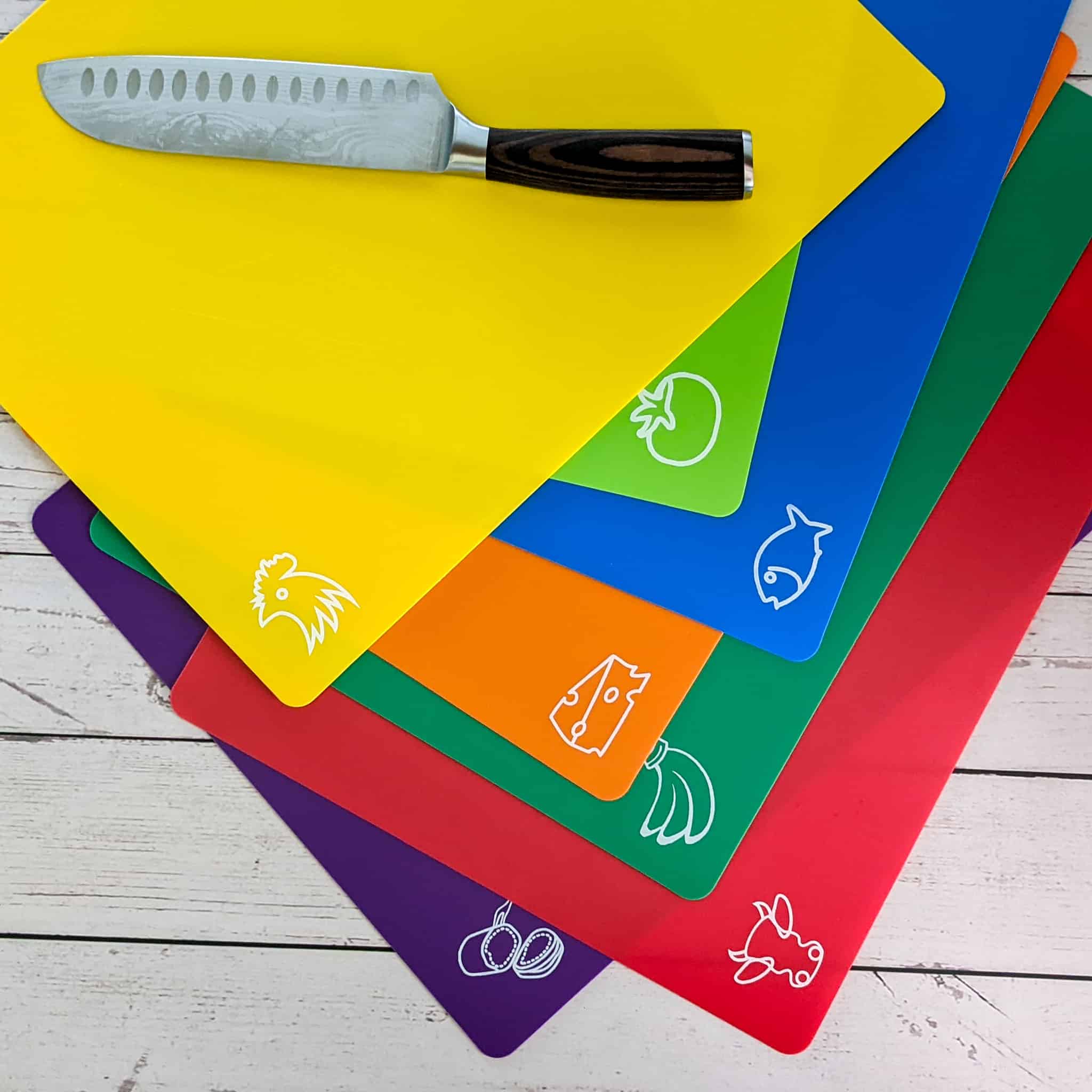



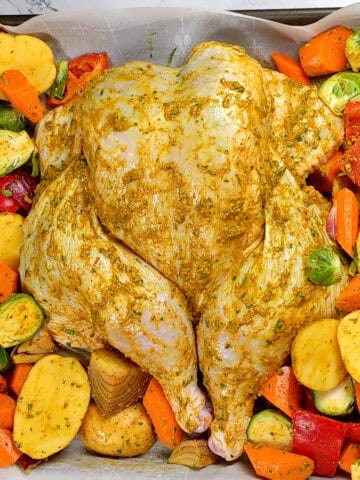
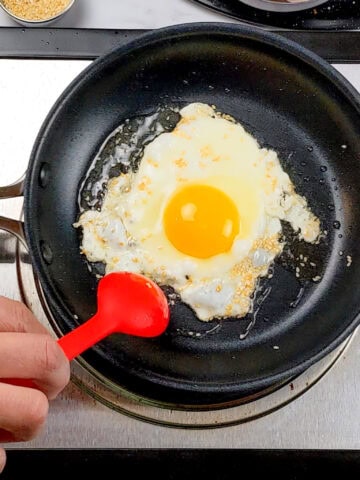
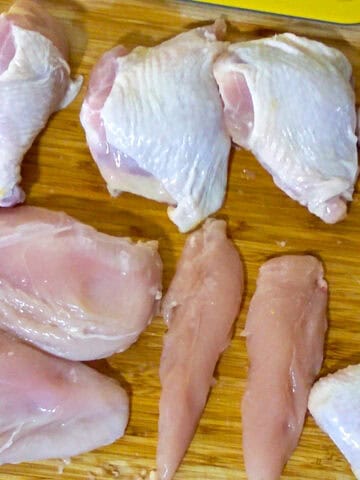
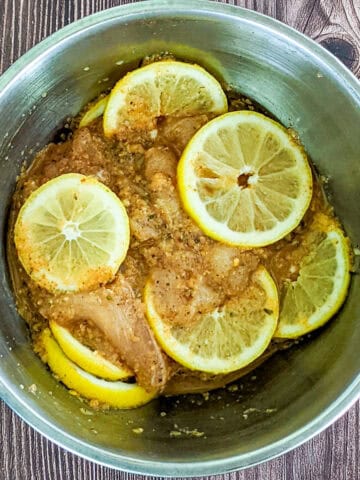
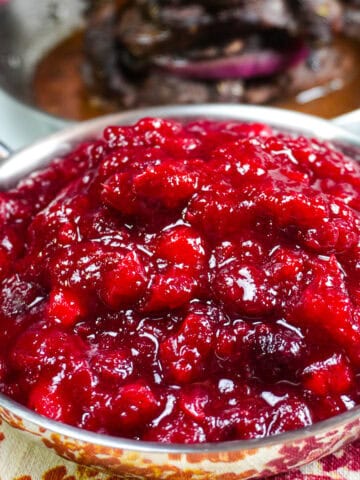
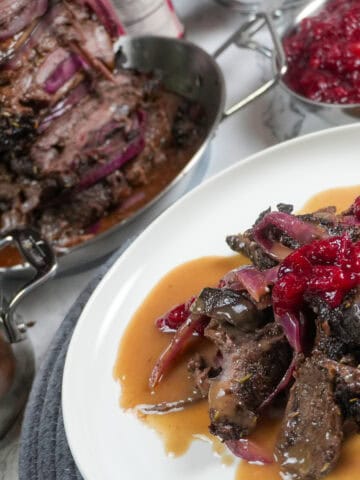
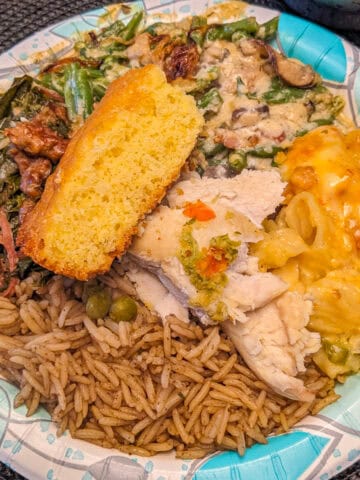
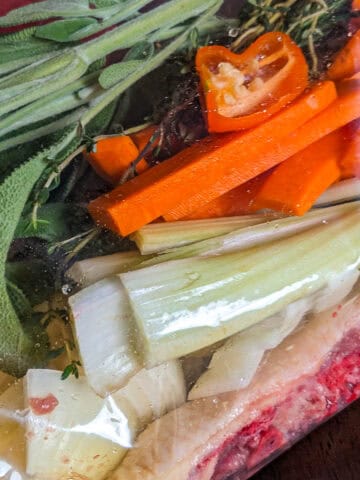
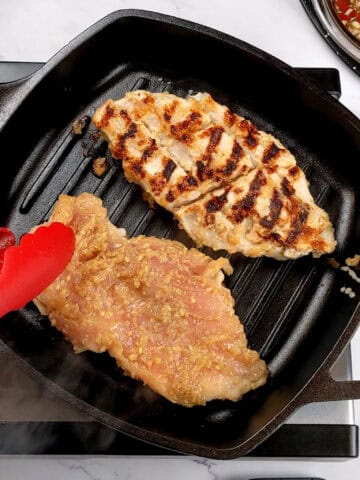
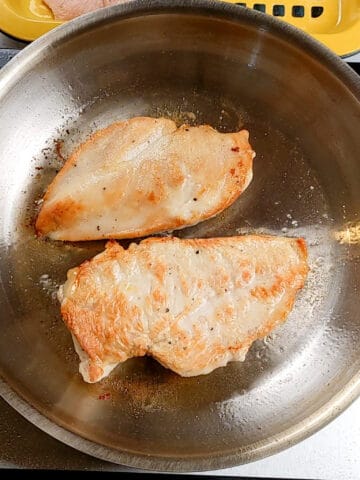
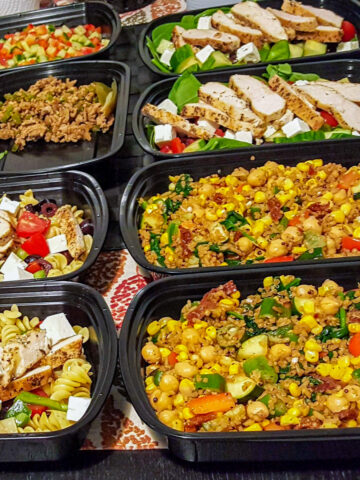
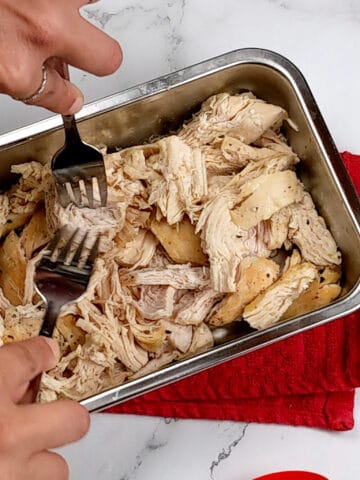
Leave a Reply